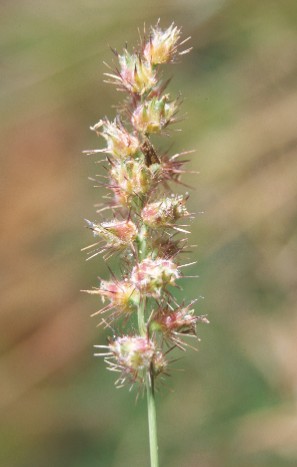Scientific name: Cenchrus echinatus L.
Common name: Mossman River grassFamily: PoaceaeOrigin:Native to central America and southern USA. Habit:an annual grass usually growing to about 60 cm in height, but occasionally reaching 90 cm. Habitat:A weed of footpaths, disturbed sites, pastures and cultivation. General description:Stems and leaves:The stems (culms) are often branched and always have hairless joints (nodes). The leaf sheath is usually hairless, but occasionally hairs are present. The leaf blades, which are 5-25 x 0.3-1.2 cm in size, usually have some hairs present. The ligule consists of a line of hairs (ie. a ciliated rim). Flowers and fruit:The inflorescence is spike-like in appearance, but is actually a reduced panicle (up to 10 cm in length). This inflorescence consists of many burr-like structures (4-10 mm in size), each having many sharp spines. These 'burrs' contain a cluster of two or three flower spikelets, and each spikelet usually produces a single seed. The 'burrs' are a reddish-green colour when young but turn straw-coloured or brown as they mature. They usually detach from the stem entire and readily attach to animal hides and clothing. Distinguishing characteristics:An annual grass which produces relatively large spiny 'burrs' (up to 10 mm in size) which readily attach to clothing and animal hides. Noxious status:Declared in Western Australia and the Northern Territory. Sources:Stanley, T.E. and Ross, E.M. (1983-1989). Flora of South-eastern Queensland. Volume 3. Department of Primary Industries, Brisbane. Weeds Australia. https://www.weeds.org.au. National Weeds Strategy Executive Committee, 2001, Launceston, Tasmania. |
Brisbane
St Lucia, QLD 4072
+61 7 3365 1111
© 2009 The University of Queensland

